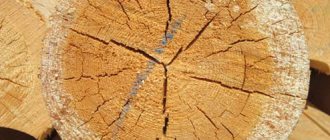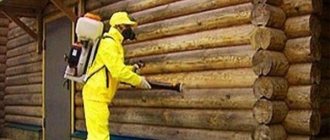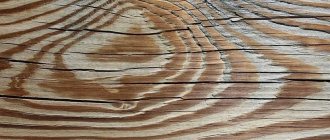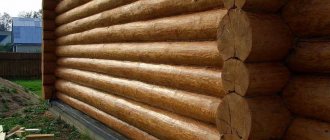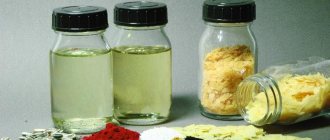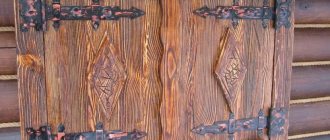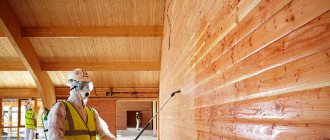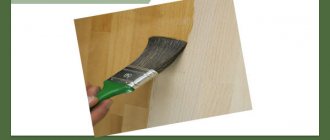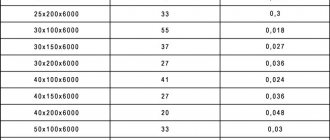Every owner of a wooden house, bathhouse or any other wooden structure asks a similar question. Once ignited, wood burns very well, so the fire can be stopped at one of two stages of fire progression. The first stage is ignition, the second stage is combustion. To fight fire at the first stage, fire retardants of the second group (lighter fire protection) are suitable, and to fight fire at the second stage it is better to use fire retardants of the first group (more serious fire protection).
Fire protection preparations are called fire retardant impregnations. Their action is to penetrate into the wood structure, providing an antiseptic effect and fire protection when the treated wood is exposed to flame.
List of fire retardant impregnations
The following are reviews of the main effective means for treating wood against fire.
REMMERS 2157 is a high quality German fire retardant impregnation for interior work. Forms a protective foam-like layer on wood that prevents ignition (second group of fire protection). Impregnation does not tolerate dampness and moisture. Before application, it is necessary to clean the wood from dust and dirt; if the wood is damp, then postpone application until the surface is dry. REMMERS 2157 impregnation is applied by spray, roller or brush. Drying occurs after 6 hours. A second coat is possible after two days. Consumption of the drug is 350 grams per square meter.
NEOMID 001 SuperProff - a product of the first group of effectiveness, prevents the wood from reaching the inflammatory temperature by creating a layer upon contact with fire. Has an antiseptic effect.
NEOMID 040 is a powerful fire retardant paint for wood.
NEOMID 450-1 is a ready-made fire-bioprotection solution of the first efficiency group. Apply in two layers sequentially at a temperature of at least +5 degrees Celsius. Produces deep penetration, excellent performance indicators. Protects against microorganisms, parasites and bugs. Consumption per square meter – 250 grams.
NEOMID 450 is a ready-made fire-bioprotection solution of the second efficiency group. Apply in two layers sequentially at a temperature of at least +5 degrees Celsius. Works great against blue stains, mold, fungi and parasites. Well absorbed, excellent performance indicators. Consumption per square meter - 400 grams.
PROSEPT OGNEBIO PROF I is fire bioprotection of the first efficiency group. Penetrates deeply into the wood and has the most effective effect. Protects against insects, larvae and fungi. Does not change the wood, but if it is in poor condition, it gives a natural look. Can be used indoors and outdoors (without constant exposure to precipitation). Consumption per square meter - 500 grams.
PROSEPT OGNEBIO PROF II is fire bioprotection of the second efficiency group. Can be used both indoors and outdoors (without constant exposure to precipitation). Protects against microorganisms and parasites. Does not change the color or structure of the wood. Consumption per square meter - 300 grams.
SENEZH OGNEBIO is a fire-bioprotection product of the second efficiency group, odorless. Deeply absorbed. Does not change the properties and structure of wood. Protects against mold, fungi, moss and atmospheric influences. Consumption per square meter - 300 grams.
SENEZH OGNEBIO PROF is a fire-bioprotection product of the first efficiency group that is odorless. Produces deep penetration into the structure. Does not change the color, tone or structure of the wood. Protects against moss, fungus and mold, as well as against atmospheric influences. Consumption per square meter - 600 grams.
WoodMaster KSD is a fire retardant impregnation with an antiseptic effect. Prevents wood from igniting (second fire hazard group). It is perfectly absorbed and does not change the color and structure of the wood. Protects against fungi, mold and atmospheric influences. Consumption per square meter - 500 grams.
WoodMaster Phenilax is a water-based fire-bioprotectant for exterior and interior use. The composition is perfectly absorbed into wood and has an effective antibacterial and fire retardant effect. Protects against blue stains, rot and mold. The fire protection efficiency group is achieved by reducing or increasing consumption. 300 grams per square meter is the second group, 500 grams per square meter is the first group. Apply at ambient temperatures not lower than + 5 degrees Celsius.
You can choose the drug yourself, but it is better to call our specialists who will give you advice and information about the availability of the product.
Wood burning, methods and means of protection
Combustion is a chemical process. Air and heat are required for combustion to occur. The combustion process occurs in two stages:
• first - combustion or spontaneous combustion; • the second is flaming combustion or smoldering.
The behavior of wood goes through several stages:
• when heated to 105°C, water evaporates from wood; • when heated to 150°C, residual moisture is removed from the wood and decomposition and release of gaseous products begin; • when heated to 270-280°C, an exothermic reaction begins with the release of heat, i.e. conditions have been created for self-maintenance of the required temperature, at which • wood decomposes with the formation of a flame and a further increase in temperature; • at a temperature of 450°C or more, flaming combustion turns into flameless combustion of coal (smoldering) with temperatures up to 900°C.
Decisive for wood fires is:
• quantity and intensity of heat supplied to wood; • heating area; • material size (chips burn better); • air flow speed (thrust).
Wood spontaneously ignites at temperatures above 330°C. With prolonged heating, the spontaneous combustion temperature decreases significantly. For example, spontaneous combustion of wood was also observed at 166°C after 20 hours. This phenomenon must be taken into account when placing wooden structures near heated objects (heating appliances, pipes, chimneys, etc.). Heat insulation conditions must be ensured such that the steady-state, long-term temperature does not exceed 50°C.
From the above discussed laws of the wood combustion process it follows that to reduce its flammability it is necessary:
• reduce the rate of heating of the surface of materials by forming a layer of coal with poor thermal conductivity; • direct wood pyrolysis towards the formation of non-flammable gases or reduce the amount of flammable gases released; • create conditions to prevent coal smoldering.
There are two main ways to protect wood from fire: protection using coatings and protection by impregnation with special compounds.
The first method of protection is to apply a coating layer (varnish, paint, coating) to the surface of the material, the protective effectiveness of which is determined by the physico-chemical properties and adhesion strength to the protected material. Under the local action of short-term ignition sources, the coating swells and creates a heat-insulating layer that slows down the heating of the surface of the protected structures to a critical temperature, makes it difficult for the flame to spread over the surface of the wood and facilitates fire extinguishing.
Fire protection by impregnation means that the wood is impregnated with special impregnating compounds - fire retardants. This method ensures that wooden structures are difficult to ignite when exposed to local fire in the conditions of an incipient fire. In this case, only charring of the material is observed, which is limited by the area of exposure to the flame on fire-resistant wood. As a result of impregnation, wood acquires the ability to increase fire resistance due to less release of flammable gases during combustion and an increase in the formation of difficult-to-burn coal.
In this case, a distinction is made between surface impregnation, which creates a fire-resistant surface layer, and deep impregnation, when a fire protection agent is introduced into the volume of wood.
Surface fire-retardant impregnation with fire retardants “MS”, “PP”, complex wood protection preparations “antiseptic + fire retardant” “MS (PKO)”, “HMHA-1110”, “”, “BB-11” makes it difficult for the flame to spread over the surface of the wood and, thereby facilitating fire extinguishing. In some cases, it eliminates the possibility of a fire from low-calorie ignition sources (match flame, cigarette butt, short circuit sparks, electric welding, etc.). All of the listed preparations belong to the II group of fire-retardant effectiveness for wood according to GOST R 53292-2009 and provide the treated wood with the quality of “low-flammability”. Impregnation of wood with fire retardant "" with retention of a protective agent of at least 160 g/m² and "MS 1:1 (DSF)" in special equipment provides the impregnated wood with the quality of "non-flammability". Fire retardant "" and the drug "MS 1:1 (DSF)" in this case belong to the means of group I fire retardant effectiveness for wood according to GOST R 53292-2009. Impregnation of wood with the above-mentioned means of protection by the method vacuum - atmospheric pressure - vacuum (VAD), vacuum - pressure - vacuum (VDV), heating - cold bath (PCB) in special equipment gives the best result in terms of fire resistance parameters of wooden structures.
Fire-retardant varnish “OZL-SK”, fire-retardant paint “Apitherm +” reliably protect wood from fire, belong to group I fire-retardant efficiency products according to GOST R 53292-2009 and are fire-retardant coatings. At the same time, the OZL-SK varnish preserves the wood texture, and the Apitherm + paint paints the wood matte white or, upon request, any light color tone.
Wood fire protection products are subject to mandatory certification in the Fire Safety Certification System.
Fire protection products produced by Antiseptic JSC have all the necessary certificates, including fire safety certificates.
You may also be interested in reading:
Methods of impregnation of wood products with protective agents
Efficiency of using individual preparations and compositions
Methodology for calculating the required amount of protective equipment
Safety precautions and labor protection during the production of antiseptic, fire retardant and hydrophobic work
Fire expert's opinion - how to protect a tree from open fire?
The construction of wooden buildings is growing rapidly due to the unique characteristics of wood. But when building a log house, you need to remember about fire safety, because... wooden material is not able to withstand fire. These safety measures concern not only the presence of fire shields, sand, a fire extinguisher that can stop the fire, but also the treatment of all wooden walls and rafters with fire retardant compounds.
Fire retardant wood treatment - features
There are different ways to use fire retardants. Common solutions:
- Surface impregnation technology.
- Cold/hot bath soaking method.
- Autoclave processing method.
Surface impregnation is a popular method of applying fire retardants to the surface of wooden coverings. To apply the antiseptic, a sprayer, roller or brush is used, so it is excellent for domestic use. This is labor-intensive and in order to create the necessary level of fire protection, you need to apply the composition in several layers.
To select the right home builder for your desired low-rise housing construction technology, use the Building Companion directory search. Examples of work and reviews are visible in the contractors' profiles; you can request an estimate of the cost of their work. Find a company to build a box house »
The technology of soaking wood in a cold-hot bath is an effective way to treat wood materials with fire retardants. The main condition for the penetration of a combustion inhibitor into wood pores is the absence of contact of wood with air when changing baths. The technology is used on an industrial scale, which makes it possible to process large wooden parts.
Treatment of wooden materials with fire retardants
Wood is an excellent material for construction, but when dry it burns well, which is unacceptable for a building, especially a residential one. To protect wood from open fire, various chemical compounds called fire retardants are invented.
There are two types of fire retardants:
- Film-forming. They form a protective film on the surface that can resist fire.
- Impregnating. They penetrate into the structure of wood and are produced mainly on the basis of aqueous solutions of salts.
Based on the type of impact, fire retardants can also be divided into compositions that swell when exposed to fire and those that form a film that reliably protects wood from fire. Fire retardants are well absorbed into wooden material and can prevent the spread of fire for a long time. It is necessary to purchase fire retardants only from trusted companies, such as Prosept and Neomid.
What are the types of fire retardants?
To select the right contractor who has a thorough understanding of low-rise building codes, search the Building Companion directory.
The profile of each company contains the necessary information, portfolio, reviews, and you can place a request for an estimate of the cost of the service. Find a general contracting and construction supervision company » Means for protecting lumber from burning differ according to various criteria. This fire protection is available on the market in different forms:
- Paste. Paste-type inhibitors provide reliable protection of the structure from flames. However, they have an unaesthetic appearance. According to this characteristic, mastics and pastes are inferior to paintwork. Due to this feature, they are used to treat surfaces that are not in visible places.
- Varnish. Such inhibitors are popular due to their ease of use. A thin layer of varnish is easily applied to the surface of the material. In addition to imparting protective properties from exposure to open flames, lumber becomes resistant to rot and moisture. The paint can have any color, and the varnish has a transparent structure.
- Impregnation. Inhibitors that provide reliable protection against exposure to open flames. However, their use can cause certain inconveniences, unlike mastics and varnishes. To properly protect the material from fire, the wood must be pre-immersed in impregnation or treated under pressure. After this event, construction work can begin.
Combination-type formulations are also available on the market. They are applied one by one. Such products are reliable, unlike pastes, varnishes and impregnations. High reliability is achieved because the new layer eliminates the shortcomings of the previous one.
Fire retardant compounds from Neomid
Neomid is a well-known Russian company that produces products for decorative processing of wooden materials and for providing them with bio- and fire-retardant properties. To carry out fire retardant treatment, you should pay attention to:
- Neomid 450. This product provides wood material with a second group of fire resistance for 5 years and prevents the formation of biological pests for 7 years. Can be used for processing wood inside and outside the building. They do not have a negative impact on the appearance, properties and structure of the wooden material.
- Neomid 450-1. These compositions provide wood with the first group of fire protection, the validity period of which is 7 years, as well as reliable bioprotection for 10 years. The application of this composition is accompanied by tinting of the wooden material in a red control shade.
Validity
The duration of the fire protection coating is influenced by various factors. If we are talking about water-soluble compounds used for treating interior coatings and not exposed to moisture, then they retain their characteristics for 3 years. The service life of protective pastes, paints, varnishes and combined fire retardants ranges from 5 to 7 years.
Any antiseptic product has a service life, after which the protection is reapplied. If the same drug is used for re-processing, then these formulations will be completely compatible. Otherwise, you need to evaluate how compatible the protective equipment is. This will prevent the risk of chemical reactions between different coatings.
Fire retardant compounds from Prosept
Prosept is also a popular Russian company specializing in the production of compositions for coloring wood and providing it with comprehensive protection. Their line of products includes the following high-quality flame retardants:
1) Ognebio Prof 1. This product provides the material with a high, 1st group of fire resistance. It also prevents damage to wood by biological agents. The composition does not contain toxic components, so it can be used to treat wooden materials indoors and outdoors. Comprehensive protection will be provided to the wood for 7 years.
2) Ognebio Prof. This composition provides the treated wooden material with fire resistance group 2 and prevents biological effects on it. Can be used for application to wood indoors and outdoors, but only under a canopy so that the material does not have contact with precipitation, soil, or moisture. This impregnation does not have a negative effect on the structure of the wood, its properties and appearance.
To ensure fire protection for a wooden house, it is better to trust the domestic compositions Neomid or Prosept. Their high quality, low cost and long service life will please many log house owners.
Impregnations and coatings for fire bioprotection: general information
Fire bioprotection for wood includes fire retardants that reduce the flammability of the material, as well as strong antiseptics that suppress the development of the vital activity of various microorganisms and insects. Often the preparations also contain UV protection. Antiseptics for fire bioprotection can be in the form of impregnations or topcoats. Typically, varnishes and fireproof impregnations for wood are translucent and, when applied, retain the natural appearance of the wood, but they can also change its shade - it all depends on the coloring of the product. Compositions for fire-bioprotection of wood vary in price depending on the manufacturer, composition and service life.
Rules for choosing fire retardants for wood
The issue of choosing a protective composition must be approached seriously and carefully. When purchasing, consider a number of points:
- Relevant quality certificates indicating detailed information about the composition of the product and characteristics.
- Method of special processing of wood materials, as well as consumption.
- Degree of fire protection. The first group provides protection up to 9% of lumber loss, the second group – up to 25%.
- Service life of the coating.
- The presence of a tinting effect.
Manufacturers often produce universal formulations that, in addition to fire protection, have antiseptic agents.
Such options are not always acceptable, since such coatings are expensive. According to experts, buying fire retardants and antiseptics is a profitable solution. Products are applied separately. The article uses photographs from the site .
Safety precautions when using fire retardants
Since there are many environmentally hazardous substances among fire retardants, it is important to first familiarize yourself with the composition. If there are warnings from the manufacturer regarding even minimal toxic indicators, then it is necessary to consider personal protective equipment. In particular, the preparation against this type of fire should be applied with gloves and a respirator. Increased safety is also ensured by safety glasses and protective clothing. And in any case, work indoors should only be carried out with working ventilation or open natural ventilation channels.
Requirements for fire retardants for wood
High-quality fire protection must effectively cope with the effects of fire, as well as maintain other characteristics of wood materials. Fire retardant coatings should not adversely affect other parts of the structure. We are talking about metal corrosion, reactions with other protective compounds, and the production of toxic substances.
Any fire retardant must have certificates. In the absence of supporting documentation, there is a high probability that the funds are produced in disregard of standards and norms. Such flame retardants are hazardous to health. Also, do not forget that different compositions are intended for different parts of the structure, as well as for a specific type of wood. All information with detailed product characteristics is often indicated on the packaging.
